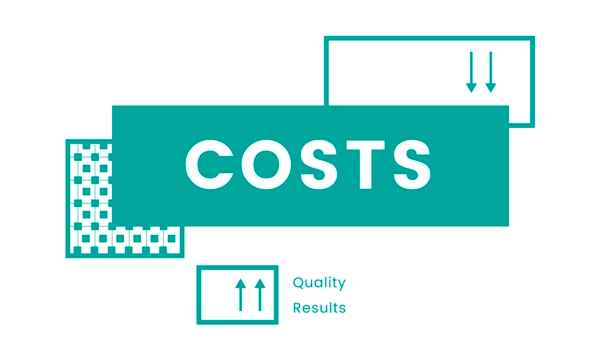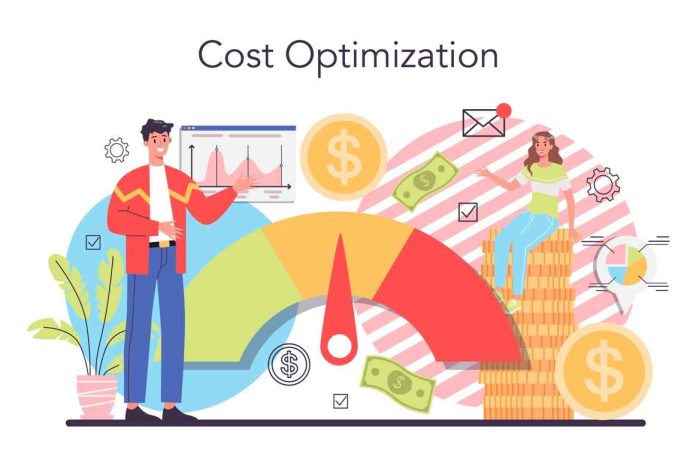The key to long-term success in the fiercely competitive corporate world of today is to maximize financial efficiency. By employing effective cost-cutting techniques for business services, businesses may significantly improve their bottom line.
Business services include a broad variety of crucial tasks, such as marketing, financial, legal, and IT assistance. These services might account for a significant amount of the budget even though they are essential for a company’s success.
Therefore, reducing costs without sacrificing the quality of business services is a major objective for many firms.
This article digs into practical strategies to save costs on crucial company services, offering insights on managing service-related expenditures effectively and controlling overhead costs in business services.
Table of Contents
EFFECTIVE COST-CUTTING TECHNIQUES FOR BUSINESS SERVICES:

Organizations must employ a diverse strategy embracing several techniques and methods to efficiently cut costs connected with key business services in today’s highly competitive business environment, where financial efficiency is important for long-term success.
This strategy involves evaluating and negotiating with suppliers, using technology, simplifying internal procedures, and managing contracts effectively.
It’s a comprehensive framework designed to save costs while maintaining or improving operational effectiveness and quality, giving firms the ability to better manage the dynamic business environment.
SUPPLIER EVALUATION AND NEGOTIATION:
The phases in the efficient cost-cutting techniques for business services that are crucial are supplier assessment and negotiation. Start by thoroughly evaluating your present service providers. Do you feel like you’re getting the most for your money? Do any cheaper options with a comparable or higher level of quality?
Asking for comparable estimates from other providers is something you may want to do. You can also feel free to bargain with your current suppliers to get better terms. In many instances, they can be ready to provide discounts or more benevolent conditions to keep your business.
TECHNOLOGY INTEGRATION:
Regarding cost-cutting, embracing technology may be a game-changer. Businesses may gain a lot from integrating technology to improve operations and save costs associated with providing services.
- AUTOMATE ROUTINE TASKS: Determine which time-consuming, repetitive jobs can be automated first. The appropriate software and solutions may help you save time, save labour expenses, and increase accuracy and productivity.
- UTILIZE CLOUD SERVICES: Take into account moving your operations to cloud-based services. With this change, there will be no need for pricey on-premises hardware, which will also lower maintenance and upgrading costs. It also has scalability, which lets you just pay for the resources you utilize.
PROCESS OPTIMIZATION:
Process improvement is a major factor in business service cost reduction. To find inefficiencies and places where expenses might be cut, review your processes and operations.
- LEAN TECHNIQUES: Put lean techniques to use in your business. Lean concepts emphasize reducing waste and streamlining procedures. This might include anything from streamlining procedures to making sure that resources are allocated effectively.
- EMPLOYEE CROSS-TRAINING: Operational flexibility may be achieved by cross-training your staff to undertake various duties. You may decrease expenses by reducing the dependency on specialist service providers when workers can fill in different positions as required.
CONTRACT MANAGEMENT:
Another area where considerable cost reductions may be gained is ineffective contract management.
- RENEGOTIATE EXISTING CONTRACTS: Review and renegotiate current service agreements regularly. During contract renewals, suppliers could be eager to provide improved conditions or reductions. Proactively looking for ways to save costs might be beneficial.
- CONSIDERING LONG-TERM CONTRACTS: Long-term contracts with service providers may sometimes result in cost savings. These agreements could guarantee reduced prices or other advantages. Be careful, however, and make sure the conditions fit your company’s requirements and goals.
REDUCING EXPENSES ON ESSENTIAL BUSINESS SERVICES:
For enterprises, striking a balance between cost reduction and preserving the quality of crucial business services is a challenging task. Although reducing expenses is essential in business services for maintaining financial stability, indiscriminate cutbacks run the risk of lowering service standards, client happiness, and overall competitiveness.
Businesses must first define and prioritize their core services, understanding that these vital tasks have a direct influence on their operational effectiveness and customer experience, to achieve this delicate balance. Then, using strategies like supplier negotiations, process optimization, and technology integration, cost-cutting efforts should be deliberately focused on non-essential sectors.
For companies to effectively navigate the competitive environment while optimizing their cost structure, ongoing monitoring and performance evaluation are crucial to ensuring that cost reductions do not affect the efficacy of critical services.
IDENTIFY ESSENTIAL VS. NON-ESSENTIAL SERVICES:
Not all commercial services are equally important to your company’s operations. Determine the crucial services that directly advance your primary corporate goals. Give these regions additional funding while giving non-essential services the lowest priority for cost-cutting measures. This strategy guarantees that you keep vital assistance while, where feasible, cutting costs.
EXECUTE A COST-ALLOCATION PLAN
Putting into practice a cost-allocation approach makes spending more effectively distributed. Based on consumption, allocate service expenses to certain projects or departments. Better cost management and responsibility amongst different teams within your firm may result from this.
CONTROLLING OVERHEAD COSTS IN BUSINESS SERVICES:

Even though they are sometimes disregarded, overhead costs in business services may negatively affect a company’s financial health if they are not handled. Rent, utilities, and administrative salaries are examples of indirect costs that may reduce profit margins and negatively impact overall financial performance. Organizations need a proactive approach to efficiently minimize overhead expenses in commercial services.
This plan includes a variety of actions, such as maximizing office space to cut down on rent and utility costs, streamlining administrative processes to get rid of duplication and inefficiency, and utilizing technological advancements that can automate tasks to cut down on labour and administrative costs.
Businesses may recover control over their budgets and manage resources more effectively by putting these strategies into place and regularly monitoring overhead costs. This will eventually increase their financial stability and market competitiveness.
If they are not properly controlled, overhead expenses may eat away at your budget. Here are some tips for reducing company service overhead costs:
IMPROVE OFFICE SPACE:
Consider optimizing your actual workplace space if you have one. You could be able to lease less space if remote work becomes more common, which would minimize your rent and electricity costs.
SIMPLIFY ADMINISTRATIVE TASKS:
Seek for chances to automate administrative tasks. This can include combining responsibilities, automating paperwork to reduce it, or contracting out certain administrative work to knowledgeable service providers.
EFFICIENT MANAGEMENT OF SERVICE-RELATED EXPENSES:
Efficient management of service-related expenses is a key component of financial stewardship for any firm. It entails a persistent dedication to tracking, evaluating, and optimizing the expenses related to the services crucial to the business’s operations.
This diligence entails a variety of procedures, including the use of thorough expense tracking tools and software to understand spending patterns, benchmarking expenses against industry norms and rival businesses to find opportunities for cost-saving measures, and keeping up with market developments and price trends.
These measurements provide companies the ability to make well-informed choices, adjust regularly to shifting economic circumstances, and make sure they are getting the most out of the money they spend on service-related projects. Companies may reduce waste and inefficiency in the management of service-related charges by paying meticulous attention to every little detail.
IMPLEMENT EXPENSE TRACKING SOFTWARE:
Implementing software and tools for expenditure tracking is the first step toward efficient management of service-related expenses. These tools have the following benefits:
- VISIBILITY: Tools for monitoring expenses provide you with a thorough understanding of your spending habits. It’s simple to track your spending, which is essential for cost management.
- REAL-TIME MONITORING: Real-time monitoring is a feature that many contemporary cost-tracking software programs provide. This allows you to make proactive decisions by keeping you informed of expenditures as they arise.
- CATEGORIZATION: Expenses may be categorized by kind, department, or project, enabling a detailed examination of the areas where expenditures are concentrated.
- AUTOMATION: Some solutions streamline the input of expenditure data, cutting down on human labour and error-prone work.
- REPORTS AND ANALYTICS: These technologies regularly provide reports and provide analytics capabilities that aid in spotting patterns and possible cost-saving possibilities.
Organizations may better understand their financial environment and identify possibilities for cost optimization or reduction by using expenditure monitoring systems.
DATA ANALYSIS AND BENCHMARKING:
A useful technique for cost control is benchmarking service-related expenditures to industry norms and rival businesses. Here is how to properly use benchmarking and data analysis:
- COMPARATIVE ANALYSIS: Examine your costs about industry averages to see whether they are within acceptable limits. If your costs are much higher than those of the sector, there may be space for improvement.
- IDENTIFYING ANOMALIES: Data analysis may be used to spot abnormalities and atypical expenditure patterns. You could, for instance, find that some departments routinely have greater expenditures than others. Investigating such abnormalities may provide the potential for cost reduction.
- TREND ANALYSIS: Analyze historical data to spot cost patterns using trend analysis. Are some expenditures rising consistently? Making strategic judgments may be influenced by knowing these tendencies.
- COST-SAVING TECHNIQUES: Data analysis and benchmarking may point to areas where cost-saving techniques can be used. For instance, you may look into more affordable IT solutions or renegotiate contracts with IT service providers if you discover that your IT expenditures are greater than industry averages.
- MARKET INSIGHTS: It’s important to keep up with changes in the market and trends in prices. You may use this knowledge during contract negotiations or when making purchase selections if you are aware of price reductions or new technology on the market.
So, benchmarking and data analysis provide you with useful information about the efficient management of service-related taxes.
You may make educated judgments to optimize spending and make sure that your company stays economically competitive and effective by comparing your costs to industry averages, spotting anomalies, and monitoring trends.
CONCLUSION:
In conclusion, improving company service cost-efficiency is a never-ending task.
Organizations may considerably decrease their service-related expenses while maintaining or enhancing service quality by implementing efficient cost-cutting strategies, lowering expenditures on crucial business services, managing overhead costs, and controlling overhead costs.
Cost-cutting is a continuous activity that calls for flexibility and an acute awareness of chances to maximize expenditures. Businesses may survive economic hardships in this manner while simultaneously thriving in a cutthroat environment.














